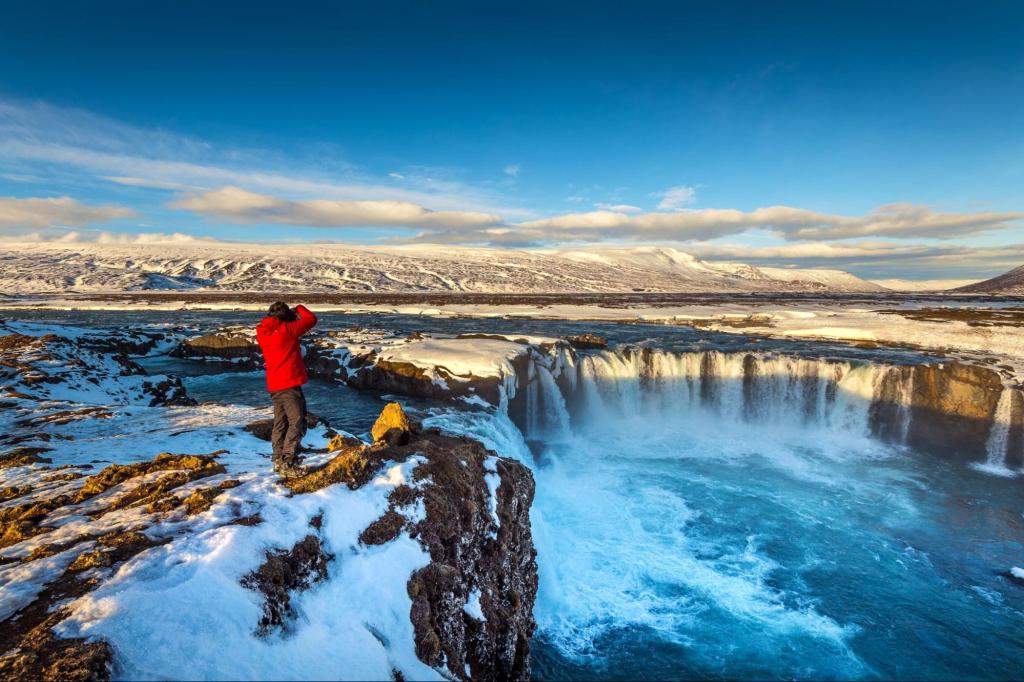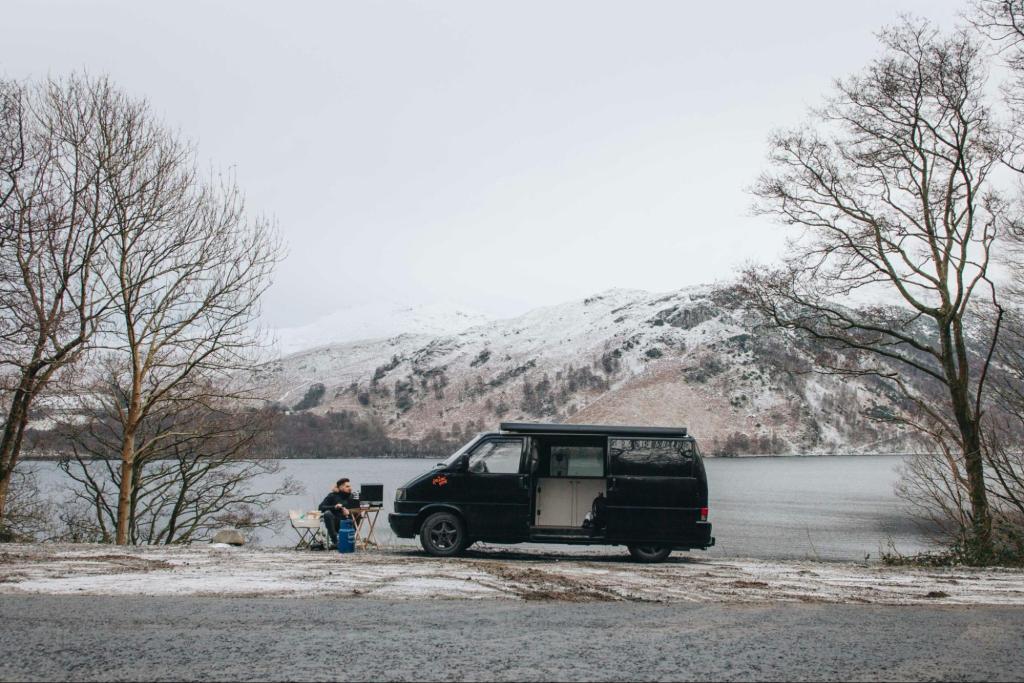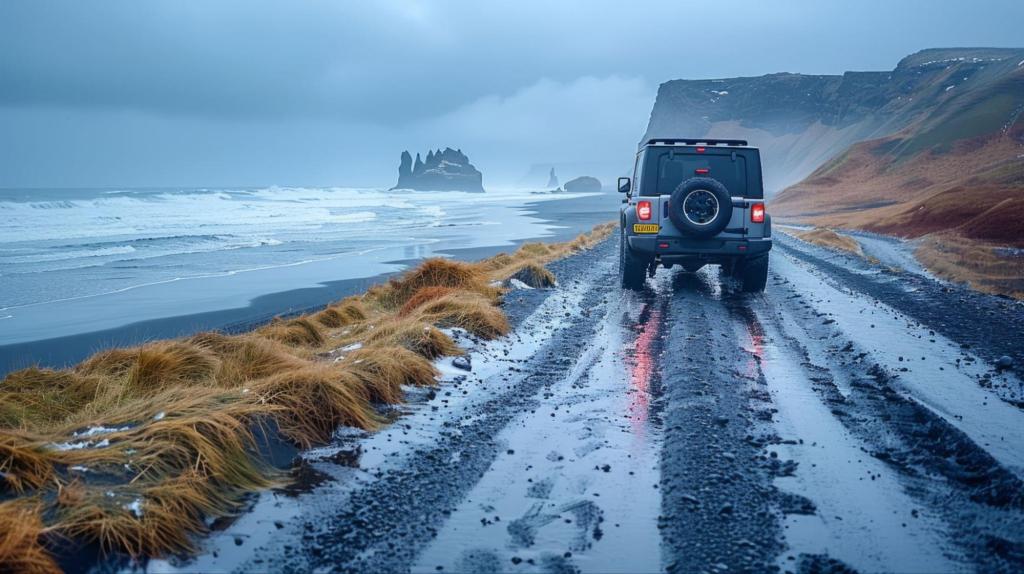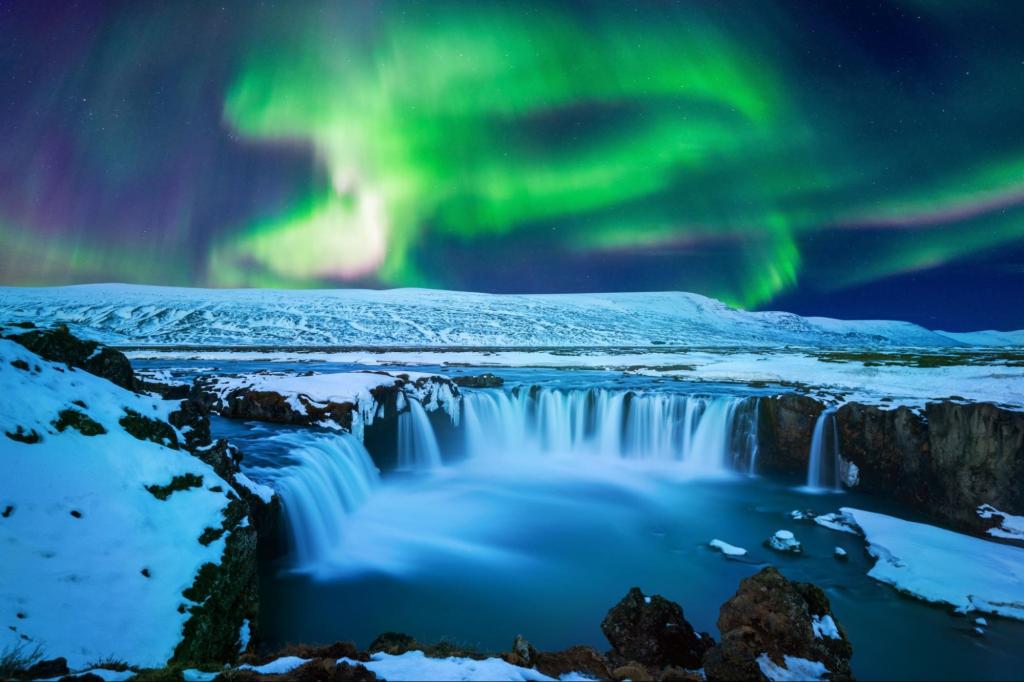


Get to know Iceland
Iceland is a high-latitude travel destination where February brings colder weather, strong winds, and shorter days. With freezing temperatures, heavy snow, strong winds, and closed roads, travel becomes less predictable and more demanding.
In this context, campervan travel becomes the most adaptable way to navigate Iceland’s changing road and weather conditions, as it combines transport and accommodation in one flexible setup. Features like built-in heating, reinforced insulation, and 4×4 traction are essential for staying safe and functional on winter roads.
To navigate changing conditions, travelers rely on real-time apps for weather updates, road status, and aurora forecasts, allowing them to adjust routes as needed. Since wild camping is restricted in winter, legal overnight stays are limited to campsites that are equipped for cold-weather use.
These constraints compress daytime sightseeing into narrow windows, while the long nights extend opportunities for aurora viewing.
By enabling access to remote places like frozen lagoons, glacier caves, and geothermal pools, campervans make the most of the season’s challenges.
February in Iceland sets strict terms for campervan travel, shaping every decision through cold temperatures, frequent snowfall, volatile winds, and short daylight spans, all of which directly alter driving feasibility, route planning, and essential gear selection.
In Iceland in winter, sub-zero conditions necessitate high-grade insulation and heating systems inside the van. Snowfall and storms can block routes with little notice, while gusty winds reduce vehicle stability and visibility.
Additionally, limited daylight compresses sightseeing windows and demands earlier shutdowns.
Rather than being a passive backdrop, the weather acts as the primary architect of movement, comfort, and safety across the entire trip.
February temperatures across Iceland significantly impact campervan viability, varying sharply by region and influencing heating demand, road safety, and route flexibility.
The South Coast, averaging 0°C-3°C (32°F-37°F), remains the mildest zone, where coastal moderation prevents deep freezes, enabling efficient heating and steady travel along Route 1 without overtaxing insulation or batteries.
West Iceland, including Snæfellsnes, averages 1°C-2°C (30°F-36°F), its inland frost creating slippery fjord roads that demand continuous defrosting, cautious braking, and access to powered campsites for sustained heating.
North Iceland, which experiences temperatures ranging from -5°C to -2 °C (23°F to 28°F), requires routine idling to prevent cold-start failures, given the prevalence of black ice and limited rest points, making high-grade insulation essential.
East Iceland, between -4°C and -1°C (25°F-30°F), adds elevation-driven chill where frost persists into midday, winds heighten exposure, and traction tools become mandatory as heaters strain under prolonged use.
The Highlands, often below -10°C (14°F), are a formidable challenge, close to all but the most reckless, as they combine impassable snow barriers with conditions that render engines, batteries, and human endurance unsustainable.
In Iceland, February snowfall occurs 4 to 6 days a week, with accumulation in North Iceland and the Highlands often surpassing 20 cm, forming persistent ice sheets and black ice that reduce traction and extend braking distances. Near-daily overnight freezing turns wet roads into slick surfaces by morning, impairing visibility and requiring de-icing, angled parking, and treated washer fluid.
Coastal zones, such as Reykjavík and the South Coast, face frequent melt-freeze cycles, where slush and hidden black ice emerge nightly, increasing closure risks on secondary and F-roads, which may remain uncleared.
Here, studded winter tires are legally and mechanically essential, as deep snow limits campervan access to flat, stable parking surfaces, restricts turning radius, and reduces heating efficiency.
Such conditions require slower speeds, longer stops, and reliance on real-time platforms like Safetravel and Vegagerðin for localized warnings.
February wind in Iceland brings sustained gales and sudden gusts regularly exceeding 50–80 km/h (31–50 mph) and campervan-critical thresholds starting at 15–20 m/s (54–72 km/h or 33–45 mph).
The South Coast channels destabilizing crosswinds that trigger closures, while Snæfellsnes and fjord valleys amplify turbulence through tunnel effects and downdrafts, directly affecting control and campsite viability.
Storms form rapidly, strike hard, and recur often, with several named systems monthly disrupting travel across regions; gusts above 25 m/s (90 km/h) have overturned vehicles and closed passes like Öxi and Hellisheiði. Vedur.is and Road Authority alerts act as non-negotiable directives; yellow urges caution, red halts movement, which demands constant monitoring and rerouting.
Every exposed route becomes a live calculation; each gust reshapes timing, control, and itinerary. As storms collapse both traction and light, the next constraint surfaces: visibility and daylight span.

February daylight in Iceland spans 7 to 10 hours; sunrise occurs around 9:30 AM, and sunset is near 5:30 PM. However, actual drive time hinges on visibility, not light. Overcast skies, low-angle glare, and wind-driven snow often blur terrain, flatten contours, and erase road cues, especially in southern and coastal regions.
Twilight offers little advantage, with contrast loss and fading line of sight further compressing safe movement. Visibility shifts hourly; a clear start can spiral into a whiteout, halving travelers’ routes or canceling the day.
These conditions force early campsite arrivals, route compression, and reliance on adaptive GPS synced with light and storm data. This interplay of light and clarity defines driving and sightseeing windows.
In February, Icelandic travel is ruled by volatile weather, shifting road safety, and limited usable daylight. Although daylight lasts 7-10 hours, only 5-7 hours are typically safe for driving, as visibility fluctuates due to glare, frost, and storms. Low sun angles delay departures past 10 AM; ice and fading light force stops by 4 PM, regardless of the sunset time.
Sightseeing remains a conditional activity; detours, missed spots, and canceled plans are standard when conditions deteriorate. Each day demands flexible routing, shaped by real-time storm alerts and road updates. In campervans, delays from heating, exposure to wind, and strict parking timing compound the challenge.
In February, road conditions are the primary constraint on campervan travel, as Iceland’s network divides into 3 winter-affected classes: the Ring Road (Route 1), the Golden Circle, and the highland F-Roads. These tiers reflect elevation-based restrictions, infrastructure maintenance priorities, and shifting passability due to weather conditions.
Route 1 is regularly maintained and largely accessible. The Golden Circle is selectively cleared but prone to closures due to snow and ice, while all F-Roads remain categorically closed due to snowpack and altitude.
Conditions fluctuate daily by region, with snow, wind, and ice altering road status unpredictably. Weather-triggered alerts and real-time road system updates require constant monitoring to reflect these changes.
The Ring Road (Route 1) is Iceland’s primary highway, encircling the island and connecting major towns through a consistently plowed, high-priority winter route, which is essential for long-distance campervan travel in February. However, segments in the Eastfjords and North can temporarily close due to snowstorms or poor visibility before reopening within hours or days.
In contrast, the Golden Circle, a well-maintained regional loop linking Þingvellir, Geysir, and Gullfoss, is a shorter route near Reykjavik that remains accessible for campervan day trips, despite occasional delays due to ice or wind, particularly on exposed or elevated sections.
Both routes are monitored by real-time systems such as umferdin.is and vedur.is, allowing travelers to adapt plans as needed; while not immune to closures, they remain Iceland’s most reliable winter driving corridors and form the structural core of flexible February itineraries.
F-Roads are Iceland’s seasonal highland tracks, which are unpaved, unmaintained, and legally restricted to 4×4 vehicles during summer. In February, they are categorically closed due to deep snowpack, high elevation volatility, and a total absence of winter maintenance, rendering them entirely inaccessible.
For campervans, F-Roads are illegal, void insurance coverage, breach rental agreements, and exceed mechanical limits. Any February travel plan must exclude them entirely, regardless of what GPS or maps suggest, as their presence on digital platforms holds no legal or practical validity.
Driving in Iceland in February requires constant adaptation to the volatile terrain, as well as campervan-specific risks such as black ice, side winds, and whiteouts, along with real-time data.
Safe movement requires daily confirmation through Vedur.is for storm alerts, umferdin.is for closures and ice conditions, and SafeTravel.is for traveler updates and recalibrations. Routes must be validated against these systems before any departure or detour, with GPS used only in conjunction with official data.

In February, Iceland’s conditions require campervans to endure severe cold, snow, and wind while sustaining internal systems and structural integrity. Suitability depends on insulation and heating, snow-road handling, and weather-resistant build.
Independent heating and high-grade insulation are essential; without them, heat retention fails, batteries drain overnight, and condensation control collapses.
Winter tires and stable traction systems are mandatory for navigating freeze-thaw cycles, while batteries must be able to start reliably after long, cold idle periods.
Externally, only weather-sealed builds with durable materials resist thermal loss and wind shear, as most retrofits and summer vans tend to fail in these areas. Unsuitable vehicles risk breakdowns, denied insurance claims, and restricted access on roads like F-roads.
In February, Icelandic campervans require diesel heaters, which are the only system sustaining heat independently through wind and sub-zero temperatures. Propane works with airflow control and a spare supply; electric fails without a constant power source. No heater equals immediate trip failure.
Insulation must be full-panel, consisting of flexible, closed-cell foam, such as Armaflex, or synthetic microfiber, like Thinsulate, applied across walls, ceiling, and floor to create a thermal envelope. This sealed interior shell retains heat and limits loss.
Floor layers block ground chill; double glazing and window covers seal thermal bridges. Without vapor barriers, moisture accumulates, causing condensation, freezing, and system failure. Bare-metal or wood-paneled interiors radiate heat loss, disrupt retention, and trigger cold floors, fogged glass, and battery drop.
Campsites are a mandatory infrastructure for legal campervan travel in Iceland during February. Wild camping is prohibited, and overnight stops are restricted to a few winter-adapted sites, primarily located in the south and southwest. Iceland campsites remain open despite widespread seasonal closures driven by snow, sub-zero temperatures, and limited daylight.
These operational sites, although vulnerable to weather-related service interruptions, support essential campervan needs, including electricity for heating and cooking, access to sanitation, and occasional water service, often suspended to prevent freezing, making electricity access the core utility.
Route planning must align with verified open sites, as snow-blocked roads or early darkness can render even accessible locations unreachable, placing the viability of campervans on infrastructure synchronization rather than full autonomy.
Most campsites across Iceland close entirely in February, especially in the northern and eastern regions and the inland highlands, where snow depth, frozen plumbing, and unmaintained roads make year-round operation impractical.
A limited number of areas remain open, primarily along the southern coast, near Reykjavík, and along accessible sections of the Ring Road, where plowed roads, functional winter utilities, and sheltered terrain converge to support minimal operations. These sites form the essential network for campervan travel, enabling legal overnight stays and access to power and heat in otherwise nonviable conditions.
Even among this narrow pool, many operate with stripped-down services, where parking only is available, no water is provided, toilets are frozen, and listed availability is unreliable, as sudden weather shifts or infrastructure failures can force abrupt closures.
Daily status checks are required for safe, compliant, and uninterrupted winter travel.

The South Coast, from Reykjavik to Höfn, remains Iceland’s only consistently viable February campervan route due to plowed Ring Road access, low elevation, and clustered winter-ready infrastructure.
While most regions shut down due to snow, frozen systems, or impassable roads, this corridor maintains a minimal but critical line of open campsites, where storm-managed roads, heated utilities, and geographic shelter converge.
Highlights such as Seljalandsfoss, Reynisfjara, and Jökulsárlón are typically accessible, each located near a heated campground or serviced town, allowing for flexible routing and reactive stopovers. Amenities are basic, often limited to parking, making daily status checks essential for ensuring a legal, warm, and safe overnight stay.
With Reykjavik nearby for fallback, and infrastructure spaced for 1-3 day travel segments, the South Coast forms the only practical backbone for February campervan itineraries, where scenic value meets operational feasibility.
The Golden Circle Drive remains one of the most reliable winter routes for campervan travelers in February, forming a low-elevation loop from Reykjavik through Þingvellir, Geysir, and Gullfoss via paved, snow-cleared roads prioritized for plowing and maintenance.
Its short distance, consistent traffic, and proximity to Reykjavik make it ideal for short-term rentals, late arrivals, early returns, or daylight-limited itineraries. At the same time, its low altitude reduces the risk of ice and the likelihood of closure.
Though storms may still disrupt travel, its maintained access and fallback value require real-time road checks before departure.
The Golden Circle Drive forms a compact, low-elevation loop near Reykjavik, linking Þingvellir, Geysir, and Gullfoss through snow-prioritized, paved roads that remain reliably plowed, making it Iceland’s most accessible winter route. Its short distance and proximity to services support safe, same-day completion for campervan travelers with limited daylight or storm-sensitive plans.
At the same time, real-time road updates help maintain access even during disruptions, positioning it as a rare February fallback with stable driving conditions, low elevation risk, and logistical ease.
The Snæfellsnes Peninsula, accessible via Roads 54 and 574, offers striking coastal and glacial scenery, but in February, it remains a weather-dependent detour for experienced campervan travelers.
Semi-cleared roads, strong winds, and irregular plowing, especially past Arnarstapi and Hellnar, can quickly turn a scenic route into a risky one, with reduced traffic, limited services, and few campsites compounding the isolation.
Travel is viable only during short, stable weather windows, requiring real-time checks and flexible fallback plans. Unlike the South Coast, this route demands readiness.

February presents high Aurora potential due to long nights and active solar phases, but actual visibility depends entirely on clear skies, cloud breaks, and geomagnetic conditions. Successful sightings require aligning dark hours with real-time sky clarity and KP index spikes.
Campervans enhance viewing odds through mobility and cloud avoidance, allowing repositioning when conditions shift, yet movement remains bound by legal campsites and safe driving rules.
Strategic planning relies on Vedur.is for cloud and aurora forecasts, night sky overlays, and KP alert apps, enabling adaptive routing without false expectations.
Some nights will be storm-obstructed or fully overcast, making flexibility and patience essential.
February is peak season for glacier cave tours in Iceland, when stable sub-zero conditions allow guided access to natural formations near Vatnajökull. Entry is strictly via licensed operators; independent access is prohibited for safety and environmental reasons.
Campervan travelers reach pickup points like Jökulsárlón or Skaftafell, but final transport requires tour vehicles and weather clearance. Routes shift annually with cave formation, and tours are often canceled, making booking flexibility essential.
Lava caving remains one of Iceland’s most reliable winter activities, with permanent volcanic tunnels offering wind-protected, cold-stable conditions unaffected by February’s surface weather.
Primarily near Reykjanes Peninsula and Borgarfjörður, these daylight-independent sites lie close to plowed winter routes, making them ideal for campervan travelers. Guided access is required, with helmets and headlamps provided; self-entry is restricted for safety and preservation purposes.
Storm-resilient and efficiently located, lava caves serve as dependable itinerary additions when other plans falter, though many require advance booking due to limited seasonal availability.
Glacier hiking in Iceland is available in February only through licensed guides operating from campervan-accessible sites on the South Coast, such as Sólheimajökull and Skaftafell, with gear provided and access strictly regulated due to the risk of crevasses.
As a weather-sensitive, tour-controlled activity, it requires booking in advance, route flexibility, and adherence to safety protocols, since storms or low visibility can halt tours without notice. Though viable for campervan travelers, it’s a scheduled, safety-led excursion.
Available year-round but limited in February, whale watching operates from Reykjavik and occasionally Grundarfjörður, strictly by boat and only during calm sea states, with frequent last-minute cancellations due to wave and wind forecasts.
Reykjavik offers the most campervan-accessible departures, making it ideal for short, flexible itineraries. However, sightings remain uncertain, as marine visibility and wildlife activity vary, making this a weather-dependent and optional stop.
Hot spring swimming in Iceland is feasible in February only at developed thermal pools and road-accessible sites that remain open, safe, and legally usable. Most natural springs, especially those located in highlands or requiring hikes, are inaccessible due to snow, ice, and unplowed roads, making them unsuitable for campervan travelers.
Viable stops, such as the Blue Lagoon and Secret Lagoon, align with plowed routes and maintained parking, while marginal sites, like Reykjadalur, depend on rare trail access and shouldn’t be relied upon. Hot springs in Iceland are not core attractions, but they serve as welcome breaks from the cold, offering warmth near legal campsites, which are best suited for clear-weather driving days.
Access varies with conditions, so only geothermal stops near overnight points or along planned routes should be considered, avoiding risky detours.
Yes, the Blue Lagoon remains open in February. It is located near Keflavík International Airport and Reykjavik, with direct campervan access via Route 41, a fully paved and regularly plowed road that is maintained throughout the winter. Booking in advance is essential due to high demand. Although weather conditions may reduce visibility and make paths icy, the facility continues to operate reliably, offering safe and warm geothermal bathing even in snow or wind.

Held in early February, the Winter Lights Festival in Reykjavik brings weather-resilient light installations and semi-outdoor performances to the city’s public spaces, offering a rare urban cultural event timed for Iceland’s darkest days.
Its fixed schedule and city-wide layout make it a storm-safe, low-effort experience ideal for campervan travelers using Reykjavik as a base, with legal year-round campsites and event locations easily reached on foot, requiring no rural driving or weather-dependent planning.
Designed for accessibility over spectacle, the festival aligns perfectly with the minimal-mileage, high-reward logic of a winter road trip.
Valentine’s Day holds no cultural weight in Iceland, but February 14 is acknowledged in tourist hubs like Reykjavik, where themed dinners, spa offers, and occasional aurora tours appear. For campervan travelers, it functions as a route-timing cue, which is ideal for planning a comfort stop, urban stay, or flexible evening activity.
Despite low-season travel, the date draws enough demand to justify early booking, turning a non-event into a logistical asset.
Þorrablót, a midwinter Icelandic tradition spanning mid-January to February weekends, features private, community-led gatherings with traditional dishes and heritage performances in rural halls.
For campervan travelers, it’s an ambient cultural marker rather than a participatory event, occasionally visible through themed menus in cities like Reykjavik and subtle local activity along rural routes. While inaccessible without local ties, its presence invites awareness and respect, embodying cultural continuity over tourism.
February campervan travel in Iceland requires space-conscious gear for sub-zero temperatures, frequent storms, and vehicle-bound living. Clothing should include moisture-wicking bases, insulated midlayers, and waterproof, windproof shells, along with thermal socks, gloves, a weather-rated hat, and dry backups for rotation.
Footwear includes traction winter boots and compact indoor slip-ons. Safety items include a power bank, a headlamp or high-lumen flashlight with spare batteries, an emergency blanket, a reflective vest, a scraper, and a first aid kit, which ensure visibility and isolation readiness.
Sleep requires sub-zero bags, thermal wear, a travel pillow, and a blackout mask for light fluctuation. Cooking demands gas-compatible van cookware, compact utensils, biodegradable soap, and quick-dry towels.
Digital tools must include offline maps, condition apps, chargers, and mobile data for continuous alerts. This is precision survival packing shaped by Iceland’s volatile February weather, unstable roads, and campervan limits.

CampEasy Opening hours 09:00-16:00
Learn more about Self-Service
A minimum of 20 hours notice is required to use the booking engine. Click here to contact us directly for a booking less than 20 hours from now.
Change Date